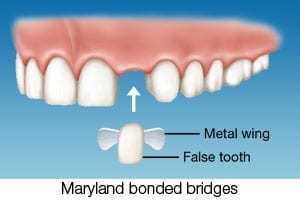 Losing a front tooth can be extremely distressing. Who wants to look in the mirror and see a black hole? And some might feel compelled to cover their mouth when smiling or talking. There are various ways to replace a missing front tooth, but most are expensive and involve the grinding down of the teeth on either side of the missing one in preparation for placing crowns as part of the bridge to support the artificial tooth. If there are crowns already present, or dental work needed on the adjacent teeth, that is an option, but you wouldn’t want to unnecessarily destroy healthy teeth. Fortunately, as long as the side teeth are healthy, this can be treated with the Maryland Bonded Bridge, also known as resin-bonded bridges, or bonded bridges.
Losing a front tooth can be extremely distressing. Who wants to look in the mirror and see a black hole? And some might feel compelled to cover their mouth when smiling or talking. There are various ways to replace a missing front tooth, but most are expensive and involve the grinding down of the teeth on either side of the missing one in preparation for placing crowns as part of the bridge to support the artificial tooth. If there are crowns already present, or dental work needed on the adjacent teeth, that is an option, but you wouldn’t want to unnecessarily destroy healthy teeth. Fortunately, as long as the side teeth are healthy, this can be treated with the Maryland Bonded Bridge, also known as resin-bonded bridges, or bonded bridges.
This is the least invasive, and also the least expensive way to replace a missing front tooth, or teeth near the front. This bridge technique was first developed at the University of Maryland, and hence the name. It was developed to avoid the trimming and crowning of otherwise intact adjacent teeth while providing a “fixed” support for the replacement teeth (pontics). The procedure is considered reversible, meaning that if the bridge is removed, the natural teeth are virtually unaltered.

